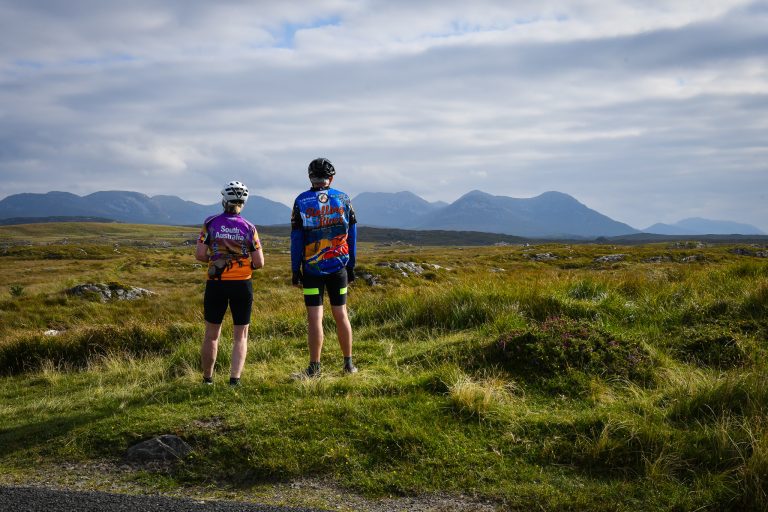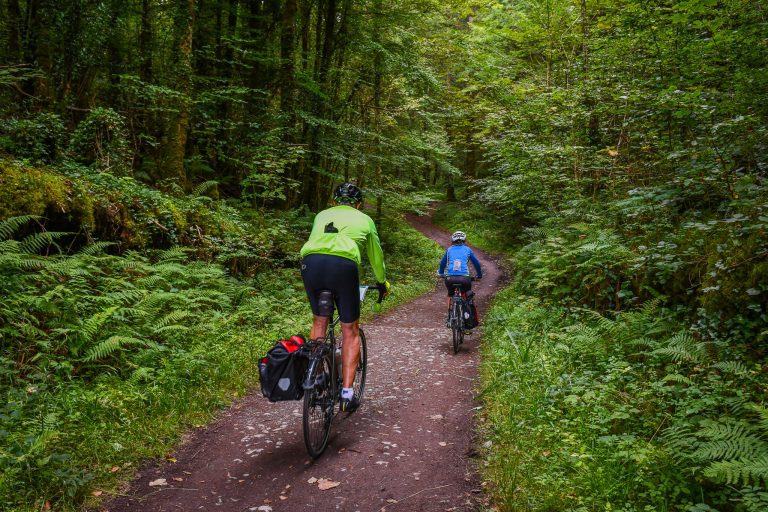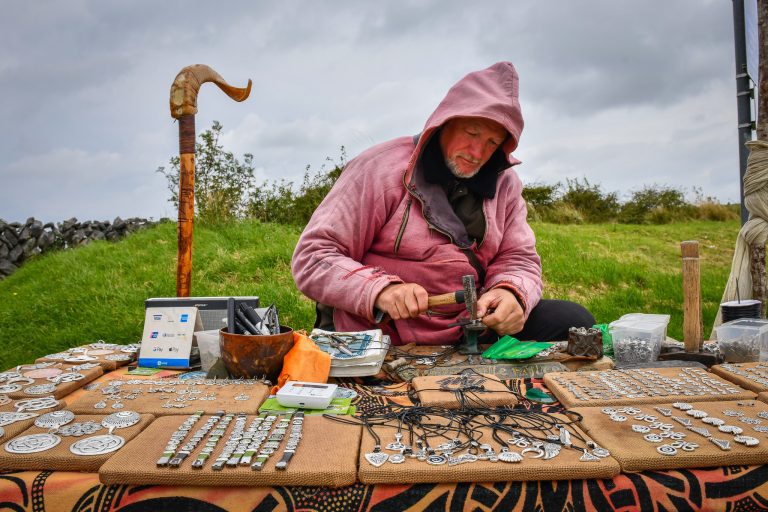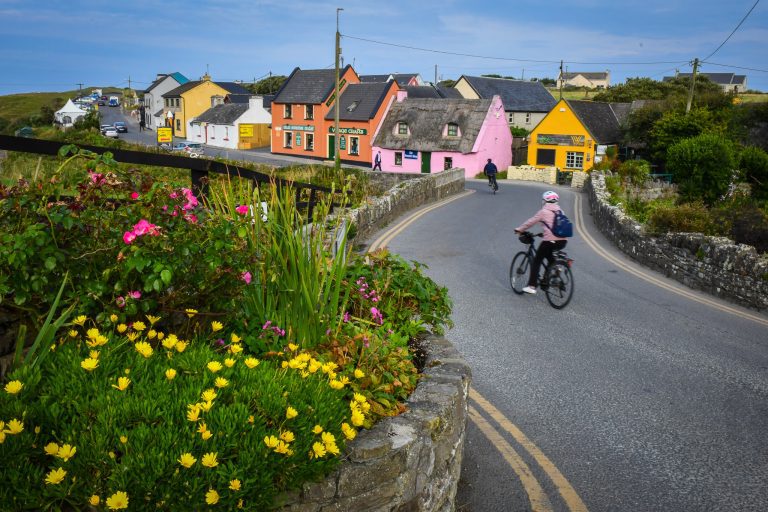Cycling upon the lightly traveled backroads of West Ireland, there’s time and proximity to experience the country, its people, history and culture, intimately.
Until recently, only experienced cyclists would attempt such a ride. Motorists would fly past as brightly colored cyclists peddled laboriously up hills, their bikes burdened with panniers (saddle bags), sleeping bags and gear. It looked impossibly physical, difficult, intimidating.
However, with the advent of ebikes and specialized cycling tours, beautiful and fascinating places have become accessible to nearly anyone, and one of the most inviting and bike-friendly places to take such a tour is along the west coast of Ireland.
What makes this type of tour so satisfying is the pace at which it occurs (avg. speed 11 mph) and the intensity of being so intimately in touch with the landscape, the people and the events that happened in the places you’re passing.
There’s time and permission to stop whenever you’d like to appreciate an historic marker, a beautiful garden, a scenic overlook. And there’s something about the physical exertion made in getting from place to place that connects the rider with the land and its people more deeply and personally than by visiting by bus, train or car.
When you stop, locals will ask from where you came and to where you’re heading. Their eyes widen when they learn you’ve ridden 15 miles so far and will be pedaling another 10 that day. Then, they are awed when you say you expect to ride 160 to 400 miles that week. It seems impossible, but it’s not. It’s done regularly by people of average physical ability.
You need not be athletic to do this, though you should prepare yourself for long rides by training on a road or touring bike at home before you go, building up from 5, to 10, 20 and eventually 30-mile rides. If you ride regularly, just increase your routine, adding a few uphill sections. Should you plan to ride an ebike, they are often available for rent in many cities, so you can familiarize yourself with how they operate before going to Ireland, should you plan to ride an ebike.
A cycling tour is not about seeing a lot of places in a short amount of time. It’s about experiencing a given place intensely and personally, at a casual pace.
A half dozen or so cycling tour companies now operate in Ireland. Of them, West Ireland Cycling is the most Irish. Established more than 40 years ago by the great uncle of Galway locals John and Shavon Kennedy, West Ireland Cycling numbers only five employees. It began offering self-guided cycling tours to promote “the culture of Ireland by getting our guests to explore by bike and meet as many people in authentic connections, as possible,” said John, “We purposefully design the tours so that they’re not staying in big hotels, but in people’s homes, B&Bs and small family-run hotels and businesses, like our own. We know that if we just get these riders out into rural Ireland to meet the Irish people not only will they learn something new about Ireland, but they’ll form real, authentic connections with them.”
Marie Power of Inishmore B&B in Galway is typical of the innkeepers hosting these cycling tours. All, like her, are women local to their towns, often for generations. They’ve become hospitality professionals with high standards of service, clea nliness and food preparation. The rooms are remodeled from traditional Irish homes to accommodate modern private baths and queen-sized beds. The breakfasts are well prepared with a broad choice of items from the classic Full Irish (two eggs, two sausage, white or black pudding, and tomato), smoked salmon, porridge, cereals, fruit, beverages, and lots of Irish brown bread, served generously.
Kennedy said 90% of his customers are over 60 years old with as many as 70% from the U.S. or Canada. They’re largely retired, have had Ireland on their bucket list of places to visit, and are casual cyclists who are more interested in getting to know Ireland than they are avid about cycling. That means the pace is restrained, exploratory and more about racking up the experiences, than miles. And West Ireland is jam-packed with experiences.
Each day, riders can choose between three options, a short ride (about 20 miles) a medium ride (40 miles) and a long ride (60 miles). This is done either by the tour company shuttling the short ride people to a midpoint or extending the shorter ride. Several routes are offered, though the most popular ones skirt the legendary Irish scenic byway, the Wild Atlantic Way to Connemara, the Aran Islands, the Cliffs of Moher and The Burren in Counties Galway, Mayo and Clare. There are uphill sections, but they are few and not generally strenuous.
This is a Gaeltacht region (pronounced gale-tauked), meaning that Irish (Gaelic) is the region’s first language, though everyone speaks English. As such, it is among Ireland’s most Irish regions where traditional culture and music are alive and practiced.
West Ireland Cycling’s tours begin in Galway, where cyclists are fitted for their bike (important to ensuring a safe, comfortable ride), briefed, meet their co-riders (if joining with others) and have time to catch up with time changes before starting the tour. The package includes a room each night at a bed and breakfast inn, luggage transfers, ferry tickets to the Aran Islands, roadside assistance should you break down (unlikely) and a Trek hybrid touring bike with repair kit and pannier.
Galway is a modern, medieval university town of 80,000. It is, at once, both ancient and young, crowded with young people on weekend nights, who listen and sway to musicians along its narrow, bent streets, dine alfresco at sidewalk enclosures, sip pints at noisy pubs as they enjoy lively “Irish trad” or congregate along the quay to talk quietly.
On a typical weekend night, you might see the street crowd lose their heads as a rock band plays cover songs across from The Kings Head, a pub that in 1653 was the mayor’s residence seized by Colonel Peter Stubbers of Oliver Cromwell’s invading forces. Stubbers is thought to have been responsible for beheading England’s King Charles I four years earlier, which explains the name of the pub. Entering the pub is to go back to the Middle Ages where wood paneling darkened by time and smoke has absorbed a thousand years of spirited talk, music and revelry. The street scene and Galway’s many festivals, events, celebrations and performing arts troupes are why the city is called “Ireland’s Cultural Heart.”
On the first day of cycling, riders are transported by van out to a starting point where they are given their bike and a spiral-bound, turn-by-turn guide that includes maps, contact information, lodging and guidance on what to do in case of a puncture or emergency. It is secured to the handlebars in a drizzle-resistant, see-through pouch, to be referred to when riding.
At intersections, riders confirm which way to turn. A wrong turn does not usually prevent the cyclist from getting to the next destination, but it might mean missing traveling along a lesser-used narrow path that might have been traveled by foot or horseback in centuries past. Often, these Sean Bòthairs (old roads) lead to spectacular views and past abandoned cottages. And that’s the point and difference of touring Ireland by bicycle.
Ireland is a nation of 4.9 million people, only a half million of which live in counties Galway, Mayo and Clare. That means there’s very little traffic on the busiest of the roads you pedal, and virtually none on the backroads and byways.
The first day, from Galway to Cong introduces you to Ireland’s lightly populated, undulating countryside. Rock walls, made of native blue limestone, scribe the green landscape. Some 400,000 kilometers of limestone walls exist in Ireland. They were constructed by farmers, long ago, to mark their land, create pasture or farmland from the rock-strewn terrain and in some cases to give people paid work during the great famine of the 1840s.
“The walls are spaced as far from the center of a plot as a person could carry a rock,” said Kennedy, “Elderly women would dig out a stone and brush whatever dirt was attached to it, to preserve whatever soil was there. Then the rock would be carried to the wall and placed. In some places, large boulders were placed as a foundation, then lighter rocks above; in other places the rocks were dry stacked vertically or horizontally with openings between the rocks to allow winds to pass through and not topple the walls.”
There were no gates in Ireland’s rock walls. When a farmer needed to move livestock from one enclosure to another, he’d remove a portion of the wall, drive his livestock into the adjacent enclosure and rebuild the wall. This was possible because the walls have no mortar. In some, not even a foundation. Today, farmers have added gates and there is a national conservation effort to keep Ireland from losing its rock walls as they collapse or land is consolidated.
The Irish countryside is not just marked by rock walls and pastures, it has a church and pub in every village. Though, the pubs outnumber the churches and they’re often at better locations. That has led the Irish to identify pubs on maps as landmarks and give directions by referencing them. On arrival in Doolin, a local gave these directions, “Ride up the road to Gus O’Connor’s pub, then left and continue past the Fitzpatrick Bar and McGann’s pub. Once you reach McDermott’s pub, your inn is 100 yards ahead on the left.”
Irish novelist James Joyce wrote in Ulysses, “A good puzzle would be to cross Ireland without ever passing a pub.” It’s a puzzle that – to anyone’s knowledge – has never been solved. So associated is Joyce with pubs that the James Joyce Pub Award is given to Ireland’s best and most traditional pubs, those which “retain a genuineness of atmosphere, friendliness and presence of good company.”
That first day of riding skirts the edges of Lough Coirib (pronounced loch), Ireland’s second largest inland water. It’s essentially a freshwater sea, so large it’s said to have an island for every day of the year. It’s an inviting water but with nary a boat upon it.
If the countryside seems familiar as you descend into Cong, it may be because you remember it from the Academy Award winning 1952 romantic comedy, The Quiet Man directed by west Ireland descendant John Ford and starring John Wayne and Maureen O’Hara. Several of the locations from the motion picture are seen in Cong, including an exact replica of the White O’morn thatched cottage from the movie which is a museum today, a bronze stature of the movie’s iconic scene of Wayne carrying O’Hara in his arms, the ancient church where the film’s characters married, the ruins of a 7th-century gothic monastery and the former vacation home of the Guinness family – 800-year-old Ashford Castle – with its magnificently crenellated towers and now serving as an exclusive luxury hotel whose interiors compare with any royal residence. To see them, you must stay there or take a peek at ashfordcastle.com.
From Cong, the ride leaves paved roads to travel along a twisting forest trail to Clonbur. Riders pass the Abbey’s ruins and cross a stone bridge beside a 16th-century fishing house which the monks ingeniously used to net fish from the River Cong. Soon after crossing, there is a lookout tower that Guinness built, though the real attraction is the trail itself. Emerald ferns, blackthorn, elm, rowan and oak trees, overgrown with ivy, grow to the edge of the compacted dirt trail. The dense forest inspires images of fairies and leprechauns hiding within it. It’s easy to imagine why Irish folklore generated so many mythical creatures when you’ve the time to consider what might be hidden behind a fallen log or ivy-choked tree as you pedal through such a lovely coill (wood).
Time to think is what makes such a tour so different. From Clonbur, there’s plenty of time to reflect as you ride toward Leenaun through a long glacier-carved valley of sheep farms. Occasionally, a farmer might stop at a high point along the road and use binoculars to locate a ram that might have climbed the lofty, viridescent slopes of surrounding hills. The sheep are identified by bold stripes of color that their owners have sprayed across their backs; it’s a code that tells the farmers whose sheep they’re seeing.
For these Irish shepherds, Joe Joyce, a sheepdog breeder and trainer, supplies border collies that descend from world champion herders. At his farm, Joyce Country Sheepdogs, beside Lough Na Fooey, Joyce runs sheepdog demonstrations at 11, 1 and 3:30 all days except Sundays and regales his visitors with stories as energetic as any an Irishman might spin. He explains that he uses voice commands and whistles to control his dogs once they’re high up on the surrounding hillsides. “Come by” means go right. “Keep away,” is go left. “Stand or Lie Down” is stop and “Walk on,” moves the dog toward the sheep. “Without a good dog, we’re not able to manage our flocks,” Joyce says. The idea is to control the dogs from a distance. He explains, “I let the dogs do the walkin’ and I do the talkin’.”
As soon as Joyce puts on his leather fedora and picks up his shepherd’s crook, his kennel of a dozen dogs start yapping and barking to be released. They all want to work. They live to work. It is their joy. The tall, gangly handler whistles sharply and the dogs quiet, then he releases his favorite, a lanky black and white bundle of intensity who has waited patiently for his signal. Off she sprints straight up the mountainside, covering 200 yards in a blink.
High on the hill, five native Connemara black faced sheep lift their heads instinctively, aware that something has changed, though they haven’t yet seen the dog. Silently, the dog loops high around and above the sheep, then approaches from behind the flock. Joyce’s commands aren’t shouted, they’re spoken softly and encouragingly, the collie responds as if wired to Joyce, moving right, left or stopping as told. “Walk on, come by, walk on, keep away, lie, lie down …” Down the hillside the sheep march begrudgingly, driven by the border collie whose insistent presence is their only reason for moving.
At the Sheep & Wool Centre In Leenaun, a short ride beyond Joyce Country, Seamus Kirwan describes Connemara’s long history of spinning and weaving. Today, the many sheep farms throughout the region depend on the export market to sell lamb and mutton and their woolen industry is largely supported through tourism which drives purchases of spun wool and knit and woven Irish tweed, sweaters, scarves and blankets. The centre – through its museum, demonstrations and store – connects travelers to the farmers and artisans, sustaining their way of life.
In one instance, as Kirwan tells it, “During the recession, things were very difficult for Liz Christy, a weaver from Castleblayney in County Monaghan. Her husband had a small engineering business in the same yard and when things got very bad she thought, ‘Oh, God, I’m going to lose my business.’ There were all these scraps falling on the floor and she was sayin’ to herself, ‘even that’s a waste. What can I do with that?’ Then she had the idea of making tiny broaches shaped like sheep using the bits of yarn trimmed from her scarves. She started makin’ them, and they started to sell. So, when she wasn’t selling scarves, the little sheep started to sell. And she calls that (pointing to the broaches), ‘The sheep that kept the wolf from the door.’ That’s what helped pay her mortgage ’til things picked up again.”
(Cont. in Part II)





